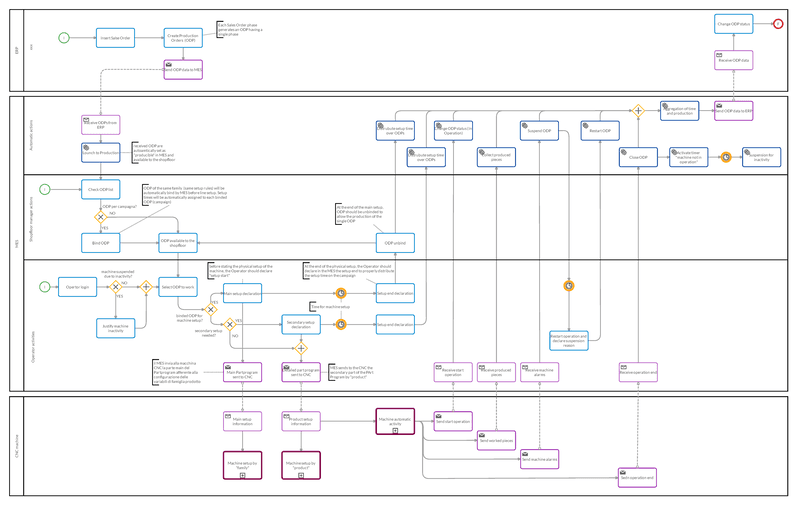Modeling manufacturing processes with BPMN and DMN standards
Written by Cristiano Ponton
12 November 2024 · 5 min read

In the complex world of the manufacturing industry, managing production processes is a crucial challenge. Efficiency, precision and coordination are paramount elements when it comes to this quite competitive industry.
Quin, an Italian consultancy specialized in Operations & Supply Chain Management, has been using business process modeling techniques as a key tool since its inception. Quin showed how software based on BPMN (Business Process Model and Notation) and DMN (Decision Model and Notation) standards can drastically change business process management and optimization, not only strategically but also from a manufacturing execution point of view. In this blog post, we’re going to discover how Quin successfully implemented these standards, the chosen tools and how they exploited them in different contexts.
Process mapping and modeling with BPMN e DMN software
Using BPMN and DMN based software in modeling business processes is key for different reasons. First of all, these standards provide a common language to describe and document business processes. This means that all the involved stakeholders, from management to manufacturing teams, can have a clear and shared understanding of those processes. This standardization is paramount to face the complexity of the manufacturing processes, where information can be scattered and prone to misunderstanding.
The use of the BPMN standard enables to map and describe them visually. As a graphical notation, BPMN makes it easier to identify activities, responsibilities and interdependencies among different processes. For example, a complex manufacturing process can be broken down in well-defined steps, each of them described by specific symbols and workflows. This visualization helps spot critical issues and identify any optimization opportunity.

Modeling processes with BPMN and DMN in the manufacturing process execution stage
In the past, in the execution phase of the manufacturing process, the focus was all about how to make machineries and the people running them interact, to gather the basic information on the execution phase. However, more recently there has been a general awareness that behind this information there are some processes that need efficient and effective management. This awareness has emerged from different understanding and conflicting answers from workers, heads of departments, IT managers, technicians and senior managers when collecting information to describe business processes.
Things get even more complicated when it comes to combining the wide array of software systems like ERP (Enterprise resource planning), MES (Manufacturing Execution System), MOM (Manufacturing Operations Management), WMS (Warehouse Management System). Not knowing all the software systems available makes it difficult to understand what tasks are run, who the responsible person is, which systems are involved and how they’re interconnected. It then becomes paramount to clearly identify every step within business processes and their dependencies.
BPMN and DMN usage has then become essential to face these challenges in the execution stage. The above-mentioned standards provide a well-structured frame to model and document business processes and decisions. Besides that, they offer a simple and shared language to the different stakeholders, helping them communicate and share a shared view of the processes.
For example, BPMN allows to create workflows showing how purchase orders are created, received, developed and executed throughout the whole manufacturing process. The visual representation makes it easier to identify critical stages and optimization opportunities.
The DMN standard, on the other side, is useful to model business decisions. In manufacturing it can establish either the rules to start a maintenance action on a specific machine, or which production orders get the priority or the final quality of a product. This helps ensure that business decisions are based on specific shared parameters.
Cardanit in the manufacturing process execution stage
At Quin, we chose Cardanit as the tool to model business processes even in the execution stage. The software offers different benefits which make manufacturing processes more efficient and accurate.
One of Cardanit's main features is the fact that it uses only some BPMN and DMN elements without confusing its users by offering all the elements palette. This allows modeling manufacturing processes in a convenient way ensuring that no detail is left aside. Additionally, Cardanit’s intuitive graphical user interface allows users to make changes in the workflows quite easily (and in real time for those with a shared document), keeping flows and connections pristine.
Another advantage in using Cardanit is that it’s cloud-based, allowing real-time remote collaboration among several analysts and clients. This means teams can work together on process modeling and optimization without being physically in the same room. Besides that, model versioning allows you to review process changes at your convenience with the opportunity to click back to a previous version.
Thanks to process modeling and to the fact that Cardanit allows you to share the workflows - including a to-be version, Quin could start developing specific software systems to cover all manufacturing execution needs. This enabled the implementation of tailor-based solutions to improve efficiency and accuracy in manufacturing processes.

Quin’s success story: Cardanit application in manufacturing execution
At Quin we successfully use Cardanit to help our clients, and all of them have a different manufacturing background. For example, we worked with a multinational corporate leader in the production of oil and gas pipes, a foundry specialized in the production of steel castings, and a producer of aluminum components for wellness and furniture.
In such varied industries, introducing BPMN modeling and the opportunity for analysts and clients to work in real time on the same workflows made a big difference. This is because it enabled Quin to generate a shared pattern for manufacturing processes with different characteristics.
So? What were the results?
- Optimizing setup times of the machineries that slow down production
- Improved IT process analysis
- Identification of the triggers of data exchange between the management software and the plant automation
- Optimized readjustments of all the systems and a general rationalization of resources, times and exchanged information.
Cardanit benefits in manufacturing processes
Cardanit’s adoption as a modeling tool meant a new series of key benefits for Quin and its clients:
- A comprehensive library: it supports BPMN and DMN elements that are really useful without confusing users with plenty of irrelevant elements.
- Ease of use: Cardanit’s intuitive graphical user interface makes the real-time modeling and editing experience smooth and maintains connections and flows.
- Real-time collaboration: being cloud-based, Cardanit allows live cooperation among stakeholders worldwide, expediting teamwork.
- Model versioning: model versioning allows a continuous control of process changes ensuring an accurate review.
- Software solutions development: thanks to process modeling, Cardanit enables to start the development of specific software systems to cover all manufacturing execution needs, ensuring the right answer is given to the client’s demand.
Conclusion
Adopting modeling software based on BPMN and DMN standards like Cardanit allows to manage and optimize manufacturing processes in a smart and efficient way. At Quin, we successfully showed how these standards can substantially improve operational and organizational efficiency. The manufacturing industry is such a competitive and evolving environment, so introducing new technically advanced tools and methodologies is paramount to keep ahead of competitors and reach full operational efficiency. Modeling manufacturing processes through software like Cardanit is undoubtedly a step in the right direction for companies trying to reach these objectives.
You can find the original blog post in Italian on Quin's website.
Further reading
Digital Business Processes Design with BPMN
Digitization and innovation: mapping manufacturing business processes with Cardanit
Process simulation with Cardanit improves leading wire manufacturing

With a degree in Electronic Engineering, Cristiano has more than 20 years of experience as software solutions manager in Automation and Supply Management. He’s been Head of Smart Manufacturing at Quin since 2022 and in 2023 he got an Executive Master in Business Administration.
With a degree in Electronic Engineering, Cristiano has more than 20 years of experience as software solutions manager in Automation and Supply Management. He’s been Head of Smart Manufacturing at Quin since 2022 and in 2023 he got an Executive Master in Business Administration.
People also ask
To get started, all you need is a basic understanding of your own manufacturing process, its main steps, roles, resources, and decision points. You don’t need to install anything: Cardanit is a browser-based platform, so you can simply sign up and start building your model online. If you’re new to BPMN or process modeling, Cardanit provides intuitive tools and templates to help guide you.
Yes, Cardanit fully supports BPMN 2.0 import. You can upload your existing BPMN file, created in other modeling tool, and continue working on them directly in Cardanit. This is especially useful if you’re transitioning from another tool or collaborating with teams using different platforms.
Cardanit goes beyond static diagrams by enabling simulation. You can assign resources, set processing times, define costs, and run simulations to see how your process performs under different conditions. This allows you to identify bottlenecks, estimate throughput and costs, and test what-if scenarios to make data-driven improvements in your manufacturing workflow.
Not at all. While BPMN can seem technical at first, Cardanit’s modeling environment is designed to be accessible. The interface is user-friendly, with visual cues and contextual help to guide you as you build your model. Whether you're a process expert or completely new to BPMN, Cardanit makes it easy to learn by doing.
A business is only as efficient as its processes. What are you waiting to improve yours?
